Okay, so we were canceled for fog today so I thought I might as well do something productive, right? I’ve been meaning to do a post on this topic, so here it is. Here are my 10 favorite review activities, in no particular order.
#1 Task Cards
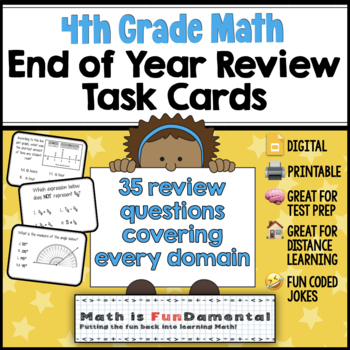 |
| One of my TpT task card activities. |
On Teachers Pay Teachers, these seem to be one of the “hot” products. And, for good reason. Task cards are awesome in so many ways. They work great for general review, center activities, group work, formative assessments and more. I’ve been using them for many years, though I never called them that. Basically, they are questions that you place around the room for students to answer. Usually students have an answer document of some sort that the teacher can check.
Upsides: Students are up and out of their seat, always a good thing. They are usually a fast and easy way to check for understanding. They allow a teacher to “float” and help students as needed. I like to add a little spice to my task cards by having them solve a code message. They love this and it makes it easy and fast to check their answers. All students are engaged. Even students who are absent can do this review.
Downsides: A lot of the task cards that I have bought on TpT have problems with them – grammatical mistakes, wrong answer keys, etc… That’s annoying to be sure, but, what bothers me more is the lack of quality questions, or in some cases, the answers. Task cards can used for higher level questions and even open response answers, but they rarely are. Most task cards I see on TpT are multiple choice answers which can be pretty limiting. My other pet peeve, especially for math task cards, is that the answer documents never have the questions on them. That makes it difficult to help a student with a problem without them bringing the actual task card to the teacher. That, of course, is soon followed by, “Mr. Pransky! There’s no question seventeen!” I like to include the question on the answer document if I can fit it on there.
 |
| A great free resource from Mary Dressel on TpT |
What’s needed: Not much, really other than questions and an answer sheet. Clipboards are nice but not necessary. Check out this awesome free product from my teaching partner Mary Dressel. She gives some great tips on how to use task cards effectively and efficiently. All of her products are top notch. If you are a Language Arts teacher, I highly recommend that you check them out.
#2 Interactive Classroom Jeopardy
How it works: Of all the games I play, this
is probably my favorite. My students really love it, too. Using the game system you can load in questions for whatever you need to review. This one takes some time to make the games at first, but once you make them you can usually reuse them for many years. I won’t go into the specifics of how to play because that is obvious to anyone who has ever watched Jeopardy of TV. The game lends itself to “quick hitter” type review, but creative question writing can allow you to go into deeper questions if you don’t mind hitting the timer button a little later.
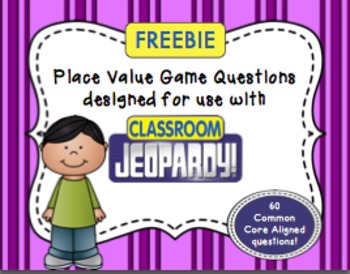 |
| Here’s an Interactive Classroom Jeopardy game I recently posted for free on TpT |
Upsides: it plays just like the real game of Jeopardy. What’s not to love? The new version of the game system even does images and videos – awesome! I wrote a grant for the new one to replace the first one we bought about ten years ago. (Fingers crossed.)
Downsides: the game system is expensive ($500 at Educational Insights, but it goes for cheaper on Amazon) Also, the game itself is a little bulky to store. Unless you get a lot of controllers and scoreboards, the game can only be played by a few students at a time (I recommend no less than six scoreboards so you can have smaller teams of around 4 students).
What’s needed: Interactive Jeopardy Game system and wireless buzzers. Also recommended for some review: dry erase boards (ex. to do math calculation questions). If you can’t afford that, there’s always the free version of the game on SuperTeacherTools. It has the advantage of being able to be saved online so kids can play at home, too.
#3 Wheel of Fun
| Modify your “Wheel of Fun”with simple rewards your students might like |
How it works: A lot of times I will use this when we need to review a skill from worksheet, something like math calculation, that after its introduced really just takes a lot of practice to master. I give the students complete a page of problems and give them an amount of time to complete as many problems as possible. Then I draw names to answer them. If the answer is correct, the student gets to spin the “Wheel of fun.” I draw up all kind of simple or silly rewards that the students can receive. My favorite is the team cheer. You should see the looks of happiness on the students’ faces when the class responds to me saying, “Three cheers for Natalie!” “Hip hip, Hooray! Hip hip, Hooray! Hip hip, Hooray!” Other categories I’ve used before are: high five, fist bump, get a piece of candy, earn Class Dojo point, class does “the wave”, ring my bell, and honk an antique car horn. You’ll probably come up with some of your own as well. Use your imagination!
Upsides: It encourages students to do as many problems as possible, otherwise they can’t spin when their name is drawn. Its adaptable. It bonds the class together in a positive way. It doesn’t take much extra time to prep or use. It frees up your smartboard to show or demonstrate problems.
Downsides: You could probably just have the students do the problems and check it faster, but its definitely not as motivating. You don’t want to do it too often otherwise it loses appeal and excitement.
What’s needed: A magnet spinner like these or make your own on the smart board. (Just search spinner in your gallery items.)
#4 Basketball shoot
How it works: I play this game similarly to the “Wheel of Fun” game above and use it to provide review and to have students check their work. Drawing names randomly, students come up to the board to shoot a Nerf basket after answering a question correctly. If they make the basket, they can get a piece of candy or other prize.
Upsidest: it encourages students to do as many problems as possible, otherwise they can’t shoot a basket when their name is drawn. Its easy set-up and can even be thrown together at a moment’s notice.
Downsides: Students who struggle won’t get as many chances to answer because they won’t finish as many problems. My suggestion is to draw their name early on the problems you think they completed. Do you have students who were wasting time when they had a chance to work? Draw them near the end. They won’t have the answer, and they’ll soon learn to use their time more wisely.
What’s needed: nerf style hoop and ball, incentive like candy if you want
#5 Dart Review Game How it works: There are a lot of fun ways to use these magnetic darts. The simplest way is just to use them to award points for correct answers in a team game. For this activity I use my chalkboard and some magnetic darts as shown at the right. I like to make my dart board interesting. For example, if I am studying weather in Science, I may draw clouds, with lightning and even a tornado on the board. Inside each of the shapes you can draw different points. Small clouds are 500 points, big clouds are 100 points, the lightning might double your points,… you get the idea. Use you imagination to make your dart board targets one of a kind. These darts also are great if you need data to practice graphing or figuring things like mode, mean, median and range.
How it works: There are a lot of fun ways to use these magnetic darts. The simplest way is just to use them to award points for correct answers in a team game. For this activity I use my chalkboard and some magnetic darts as shown at the right. I like to make my dart board interesting. For example, if I am studying weather in Science, I may draw clouds, with lightning and even a tornado on the board. Inside each of the shapes you can draw different points. Small clouds are 500 points, big clouds are 100 points, the lightning might double your points,… you get the idea. Use you imagination to make your dart board targets one of a kind. These darts also are great if you need data to practice graphing or figuring things like mode, mean, median and range.
Upsidest: The darts add an element of luck so students don’t get too down it they lose. Plus, throwing darts is fun!
Downsides: If kids throw the darts too hard, they’ll bounce back and fall off. Sometimes you’ll need to make a judgement call about throws on the lines. Some chalkboards and dry erase boards aren’t magnetic.
Needed to play: Magnetic darts and a magnetic surface. I ordered my darts off of Amazon for less than $5.
#6 Math races
How it works: Split students into teams of about four. Each team should be seated in groups and gathered in a way that can help them work together. Each team has a representative who is the “point” person for that question. This works best for math calculation problems that take a little time to answer. It rewards accuracy and speed. Typically, I announce a math problem such as “648 times 7.” The students answer the questions as quickly as possible on their wipe off boards and when done the “point person” grabs a numbered index card that I have placed on a stool in the middle of the room. The top card should be labeled 1, and the rest should go down in order for the number of teams you have. These cards represent finishing order. Once I see most everyone has answered the question and all of the cards have been collected, I ask the team who finished first to show their answer. If correct, that team earn one point. If incorrect, then I move on to the 2nd finisher, and so on. Importantly, I also award one point to each team if everyone on their team has the correct answer. This encourages all students to participate in answering the questions, and it promotes cooperation among the teams. So, all teams who get the problem right get a point. Teams that finish first get a bonus point.
Upsides: Students must work together to be successful. Teacher can adapt the time and difficulty of questions as you go. Speed is rewarded, but so is accuracy. Kids get to move a little bit.
Downsides: Sometimes students finish at the same moment and there may be a fight to get the lower card. Its best to establish rules here before you start, such as no running, and first person to touch the card gets it. If you have students who are really slow or do not know how to do the work, their team can get discouraged with them. Part of the “pre-game talk” needs to include that cooperating is not copying answers. This means that teammates should take the time to help explain the correct way to solve a problem if someone is wrong, rather than just have them copy it. Proper distraction of ability levels between teams is important here, too.
What’s needed: Index cards labeled 1-5. Dry erase or chalk boards to show work and answers. Some questions to give students that require a little figuring.
#6 Eraser Slide
 |
How to play: This simple game requires a chalk/dry erase tray and an eraser. As you as give questions to various teams, each team sends a representative up to slide the eraser for points after answering correctly. The board is set up with various point values. I usually surround a big point value with two hazardous values such a zero points or bankrupt.
Upsides: Easy set up. The kids have never done anything like this before and they think its fun. It also has an element of luck which makes losing easier for your highly competitive kiddos to swallow.
Downsides: Sometimes the students get a little excited and toss the eraser right off the board. It’s actually kind of funny when it happens, though. Also, you’ll need to decide what to score if it land on a line. Sometimes I give a “line score” or just split the difference between the two numbers.
What’s needed: A chalk tray and and eraser.
#7 Smartboard Games
How to play: These can be downloaded all over the internet for free or you can make them yourself. If you use Smart Notebook, search their Smart Notebook exchange of free games of all sorts. I still prefer to make my own Powerpoint or Keynote games because the software is more robust, and its just easier for me to build a set of questions quickly. Often I’ll pair one of these with the spinner, darts, or eraser slider methods mentioned above to use to generate points. I’ll also often export these in a way so that students can play them online for practice before a test.
Upsides: Adaptable and interactive. Can be published online to be used as a study resource at home.
Downsides: I can’t think of any.
What is needed: smartboard or other way to display the game, a way to track points
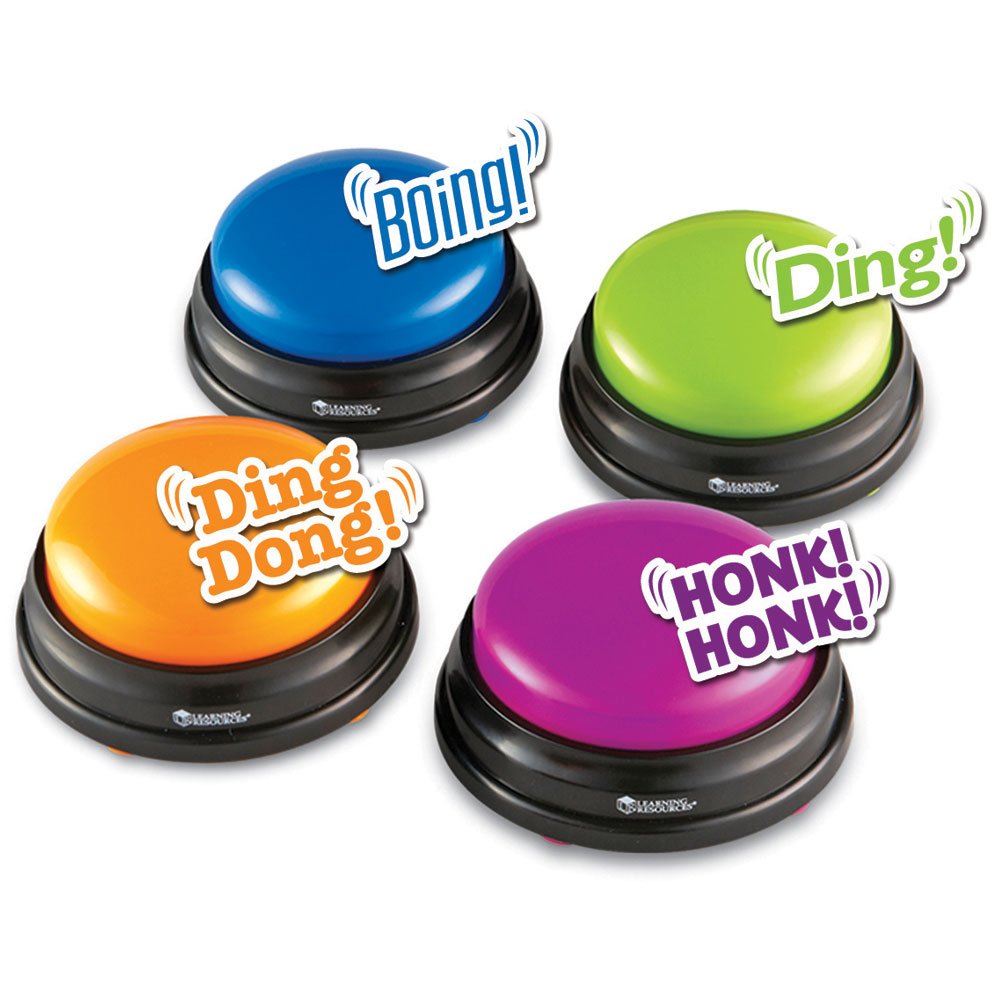 |
| A cool buzzer set I found. |
#8 Head to Head with “Buzzers”
How to play: Sometimes you may want players to go head to head such as in the game Family Feud where the fastest correct answer is rewarded. Here is an easy link to a site that gives you an interactive buzzer to use for this type of game. For a lower tech option, just put a ball or other object on a stool and the first person to grab it gets to answer. Its even more fun if you can use bells, horns, kazoos or other noise making devices to tell who answers first. This can work if you want to get all of the teams a chance to answer. I’ve never used this, but I found this on Amazon, and it looks like a great option as well. For another, low tech option, you can even assign each team as a farm animal noise to tell who buzzes in first.
| a crude looking but effective online smartboard buzzer |
Upsides: Easy set up. Adaptable to any type of review, but best suited to quick hit type questions.
Downsides: Not all students are engaged while you do this, so it works best for quick review activities.
#9 I Have… Who Has… Games
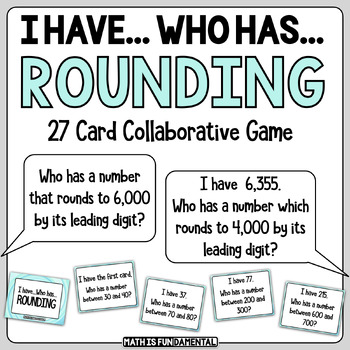 |
| See my free product for Rounding I have…Who has.. on TpT as an example |
How to play: These were introduced to me a few years ago, and I have used them as staple station game ever since. Students begin with a starter card and read an “I have…” statement followed by a “Who has..” question. This leads from card to card until all of the cards are read. I usually give each group a timer and have them record their time. This gives a goal for improvement if they do it again or a way to compare if they are competing for the best time. I like this to be played in groups of 4 or 5, but it can work well with a whole class, too. The reason I like smaller groups is more student involvement. When you play as a whole class, students tend to tune out after they read their single card.
Upsides: After initial training, students can play the game in small groups without much guidance. Students like to compete to beat the class’s “best time.” Students improve their listening skills and focus by playing this game. Teammates tend to apply positive peer pressure when a student isn’t ready to answer, and it costs the team extra time.
Downsides: If students get off track and answer with the wrong card, its very difficult to find the mistake. They generally just have to start over. It can be frustrating if one person is not paying attention and everyone is waiting for them. Playing this with a whole class is fine to show how to play but, in my opinion, this doesn’t give students enough of practice of the skill.
What you need: A set of “I Have..Who Has…” cards. I recommend to make a couple sets of them for when students finish their work early. Its also recommended to have an “answer chain” to check work or to help if they get stuck.
#10 “Memory”-style Games
How to play: Remember the game Memory you played as a kid? Like the “I Have…Who Has…” game mentioned above, this activity is easy to learn and gives invaluable practice of skills. This activity works best with things you want kids to memorize that come in natural pairs, such as matching 7 x 7 with 49 or vocabulary words and their definitions. What you need is a set of cards that are paired in this way. Students lay the cards face down and then draw two at a time looking for pairs. When a match is made, the player goes again. When no match is made, the challenge is to remember the position of the cards to help match them later.
Upsides: Game gives a lot of repetition of concepts as cards are turned over and
read again and again. The game is simple enough that it can be started and played independently by groups of students. It can be played in partners or even larger groups so its flexible in that way.
Downsides. Game is really limited to review of things that can be paired.
What you need: Cards for ideas that you want students to remember that come in pairs. See my example of pairing different forms of numbers.
Some general tips that I think make review activities successful:
- Keep the focus on the skill you are working on rather than the other aspects of the game. Part of my “pre-game speech” is always that the main reason we are doing the activity is to learn. If the focus becomes winning or students do not show self-control or good sportsmanship, then we will find a less exciting way to practice.
- Use sounds to add an element of excitement to your game. I use a teacher bell when a question is answered correctly. You’d be amazed how a little thing like that can make the game more fun. You can use other online sound effects like this or these for dramatic effect.

- Fairness is important, but remember you are the game master. Keeping the right balance of competition, skill, and luck to keep everyone engaged in a game is tricky. If I find a team/player is getting discouraged and not getting involved, I may double point values or make the final question worth one million points so all teams feel like they still have a chance to win. As the game host, its possible to manipulate here and there to even things out if necessary. Always strive to have games end on a positive note for everyone.
- Variety is important. Even the most fun activity gets boring if you do it over and over again. Change up your games frequently and your students (and you) will stay excited to play them each time.
- Get everyone involved. A problem with some games is they only involve a few students at a time. Find ways where all students can think through the answers. One way to do this is to randomly choose students to answer. If students know they may need to be next to answer, they will be more alert during the game.
- Cultivate an atmosphere that encourages cooperation and encouragement within teams. Positive language should be modeled and praised when it is used by students. This should be an essential part of your “pre-game talk” with your students.
- Games don’t have to end in prizes, candy or other incentives. The primary goal of the activity is to learn in a fun way. The learning should be its own reward and if you can have fun while doing it, that is a bonus. When students ask me what they get when they win, I like to answer, “smarter.” (Credit to super teacher Melissa Gottschalk for this great comeback.)








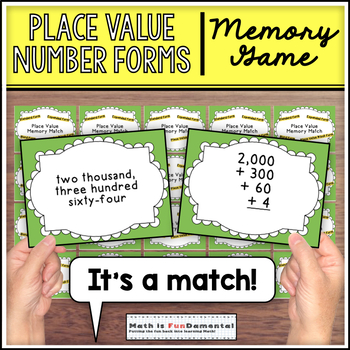
I love "Eraser Slide" and "Wheel of Fun". Those are new to me (and therefore, probably the kids), easy, and best of all cheap! Also, not time consuming to create. I'm a new follower on TpT. Keep the great ideas coming!